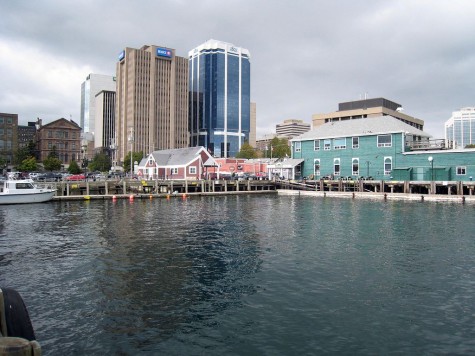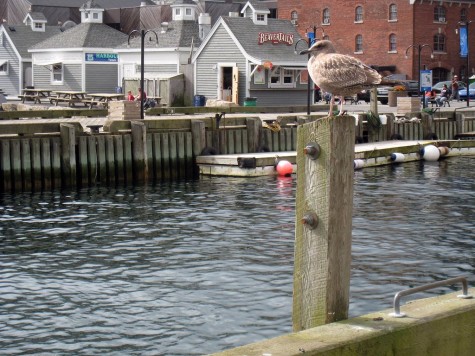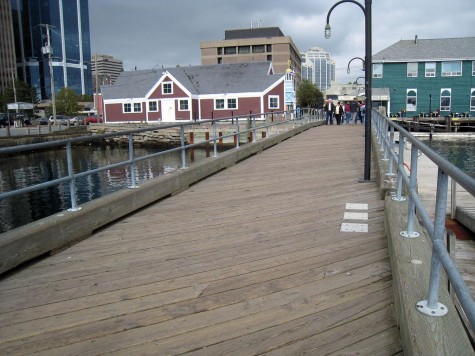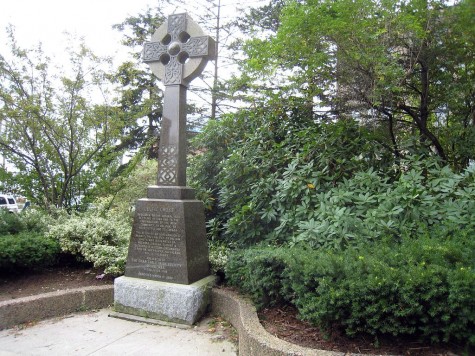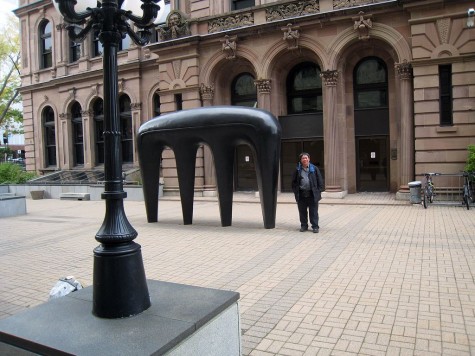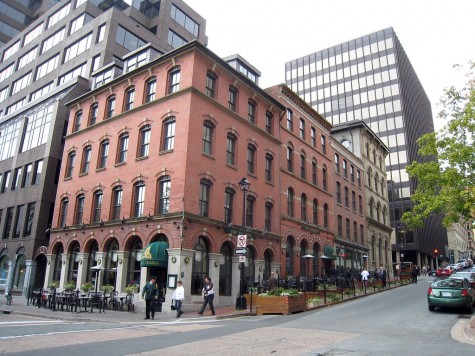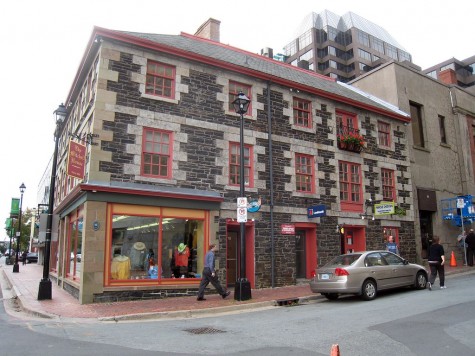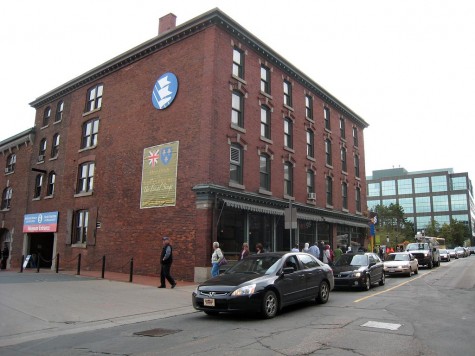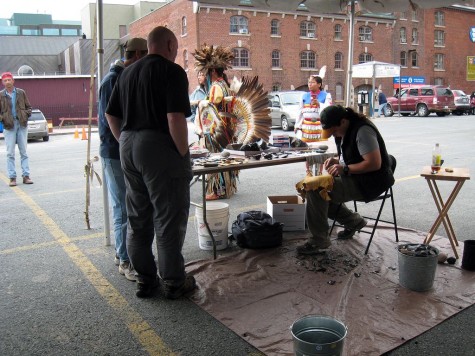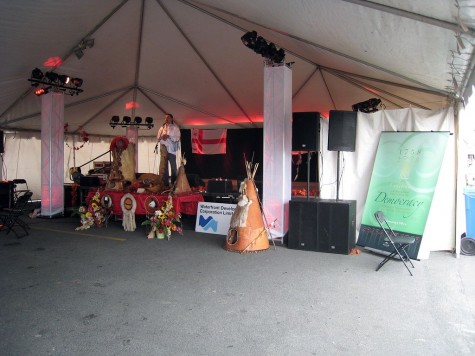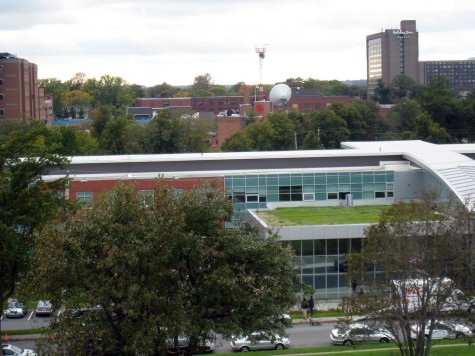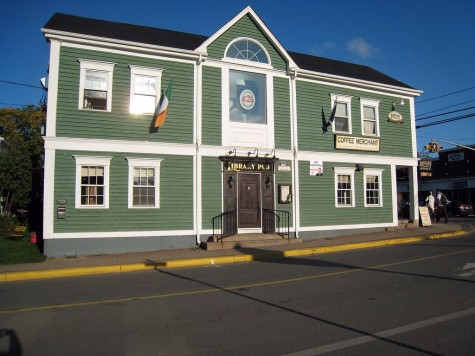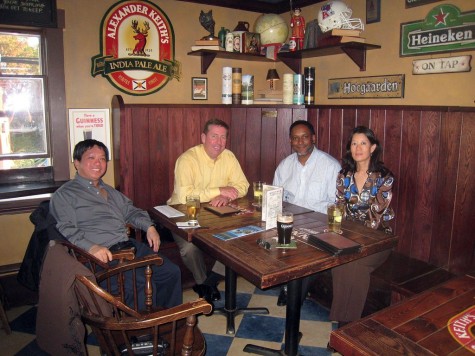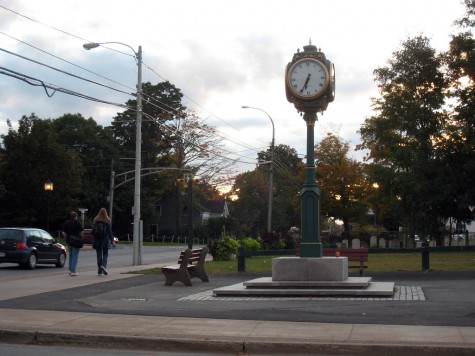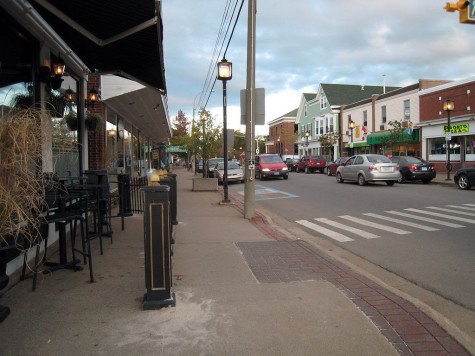Across the bridge, we drove south and then nativated around some building towers to find roads down to the waterfront. We parked the car, and walked out onto Queen’s Wharf Pier. Looking southwest gave a great view of the city on a cloudy day.
Turning counter-clockwise, and looking south we saw more piers on Halifax Harbour.
Continuing counter-clockwise, Georges Island has a lighthouse as a navigational aid to shipping.
Continuing to pan, almost east, are the refineries at Dartmouth Harbour.
Skipping past the bridge to the northwest, I could see the towers that we had to drive circles around.
As we were walking back inland from Queen’s Wharf, I noted a well-fed bird on a comfortable perch.
Northbound, as part of Harbourwalk, we crossed over a pedestrian bridge between the piers.
Just off Queen’s Wharf is Murphy’s on the Water.
Moored just beyond is Theodore Too, a large scale replica of Theodore Tugboat.
Turning landward, I noticed a marker declaring “Halifax: Here We Began”, placing Chebucto Landing nearby.
We had flown from Eastern Time into Atlantic Time, so we were hungry for lunch.
The pub food at Stayners Wharf was convenient.
After lunch Stephen retreated to the car for a teleconference. Geovanni, Nancy and I went for a short walk westward, up George Street.
This took us past a Celtic Cross, placed on the site in 1786.
On the next street, up some stairs, we found the back way to the plaza and some interesting sculptures outside the Art of Gallery Nova Scotia Halifax
We stepped into the building, but didn’t have time to tour the gallery. I noticed a painting high in the atrium of the entry.
Continuing, away from the water, is the Province House. I was surprised that legislature building is so modest. The building was first put into use in 1819, long before Canada became a country.
At the south end of the Province House is a statue of Joseph Howe, who led Nova Scotia as the first British colony to win responsible government in 1848.
Walking south, we saw the old Halifax fire station, now McKelvies.
Of a similar vintage is The Old Triangle.
The Mitchell House is another historic building in the neighbourhood.
Our time was running out, so we headed back to where we had parked the car. We passed the Maritime Museum of the Atlantic on the way.
It hadn’t occurred to us that is was Treaty Day in Nova Scotia. The Mi’kmaq had set up a tent by the Harbourwalk.
Small tables were set up selling crafts. Some artisans were working on pieces.
Festivities were just starting up on stage. We couldn’t stay, as we had to go to our meeting.
The destination of our next meeting was in St. John, New Brunswick, on the following day. There isn’t a practical airline service between Halifax and St. John, so the best alternative is driving. Before we left Halifax, we detoured up the the big hill to the Citadel National Historic Site. Without the luxury of time to go into the site, our best view was a drive-by of the back entry.
From the heights, the view northeast looks away from the city centre.
To the west, the foreground buildings are either institutional or commercial.
Our destination would take us northeast, by the city centre and back across the bridge.
There’s two driving routes to St. John: one 4 hours via Moncton around the Bay of Fundy, or the other almost the same time to Digby and then a ferry across the bay. We had agreed that the latter would be more fun. As we drove north and west, the weather cleared. I had seen a mention of Wolfville as potential place to stop for dinner. We didn’t have a local map, so when we pulled off the highway, we were aimless. We thought we had found a solution with the Wolfville Memorial Library, but it was closed. Fortunately, we found a large town map on a kiosk in the park next to the library.
Reoriented towards Main Street, we discovered a variation on the theme: the Library Pub.
This is when we discovered Nancy’s preference for dark, dark beer. We were all delighted that the menu offered more than the average pub. Our choices made this cosy upstairs restaurant a great choice.
Across the street is Clock Park, certainly a landmark for the town.
Wolfville is small. After dinner, we could have had an easy stroll down Main Street.
We continue our drive to Digby. As the night fell, we had the uncertainties of never having driven the route before, with detours around some road construction in the dark. The weather got worse again, and we ended the evening at the Digby Pines Resort, unloading our luggage in the rain.






